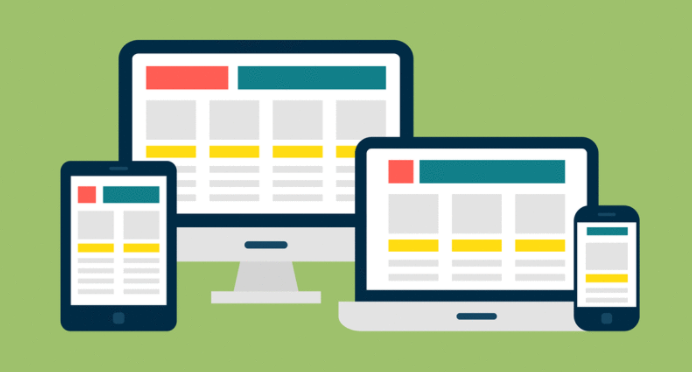Responsive web design is a strategy for building websites that makes the site look great on any size device and screen. It is the art of crafting websites to appear appropriately across all devices, from desktop monitors and tablets (responsive) to smartphones (adaptable).
The web is not a one-size-fits-all, so it only makes sense to have websites that respond accordingly. Responsive Web Design (RWD) offers the best of both worlds: fixed width for desktop computers and liquid layouts with fluid images or text on mobile devices. The implications are huge.
Responsive Web Design is the newest, most progressive way to design websites. With responsive web design services, you are able to create one website that can be viewed on smartphones and tablets as well as desktop computers without any need for multiple versions of your site.
Responsive Web Design (RWD) is a new technique where designers build sites with fluid grids so they know their website will always look good no matter what size screen it’s being displayed on. RWD allows users to browse content in different ways depending upon which device they’re using – whether it’s a smartphone or tablet; they’ll never be an issue finding things again.
In today’s digital world, it is more important than ever for Web developers to keep up with the latest trends and technologies in order to provide a satisfying user experience. Responsive web design (RWD) offers an adaptive solution that uses fluid grids which resize automatically depending on the size of your screen or device. It has been noted by many as being one of the most innovative advances in UX since mobile browsing came into existence due to its ability to offer seamless usability across all platforms and diverse devices from desktops to laptops and everything in between.
How to Create Responsive Web Design:
- Learn everything you need to know about creating a responsive web design
- Get a clear understanding of what it takes to become an expert in the field
- Improve your chances at giving your website better visibility online
- Understand what in-demand skills are necessary for professionals and how they can be attained
- Inform readers on what to do in order to create a responsive design
- Provide information that is helpful for designers and webmasters
- Help you make better decisions about your website
The basics of responsive web design services is that you create one version of each element (image, text) in an HTML document that fits all devices so no matter what device someone uses they’ll always get the same experience when viewing your page. You need to decide if there’s anything specific about certain types of browsers that might cause issues – then use CSS media queries. These allow developers to adjust their site depending on screen size widths and orientations.
Why Responsive Design Matters?
Responsive design is a term used to describe the layout of web pages that are able to change their style depending on what device they’re being accessed from. Take your desktop computer and your smartphone, for example, both devices have different screen sizes which means that when you visit an online webpage it will show up differently in each one (a simplistic explanation).
People with smartphones usually use their thumbs or fingers to navigate through websites instead of using all ten digits like people who access sites via desktops do so because this input method causes them less strain than other methods such as trackpads and mice would. When designing pages for mobile users keep these things in mind: make sure links are easy enough to press by touch alone.
Responsive Design is the Future of Web Design:
The importance of a website being responsive can’t be overstated, especially in today’s mobile world and given that so many people are relying on their smartphones to browse the internet through any time they have available during the day to day life with work or family commitments taking up most hours between 9 am-5 pm. The goal when designing for responsiveness is to create an interface that will allow users from all devices – smartphones, tablets and more, as well as those browsing using desktops –to access your site more easily than before (and much better) by customizing it according to each individual screen size requirement including but not limited to: width; height; orientation such as portrait mode vs landscape mode.
How to Make Your Website Responsive:
The most important thing that you can do with your website is to make it responsive. A responsive web design services adjusts its layout and contours depending on what screen size the user has chosen, so they’ve never left scrolling around or zooming in-and-out trying to find content from their phone or tablet. There are a couple of ways for web developers like yourself to test if this feature will work well.
“Viewport metatag”: This tag tells browsers how large an area should be used as the viewing region (e.g., “width=1000px”). It’s good practice when developing websites because some devices may not allow users to manually changing those settings within their browser, nor does every device use exactly 1000 pixels width resolution.
Development Blog:
Development Blog is a place for developers to share their progress and communicate with the outside world. The Development blog allows programmers to keep up-to-date on what’s happening in the industry, as well as interact amongst themselves about any new developments or trends that may be helpful during certain projects.
A development blog is a diary for developers to share their work, thoughts and knowledge. Have you ever wanted your own private space where you can post about any of your development projects? Development Blog provides just that! It’s like the online journaling tool version of Facebook – but without all the annoying family members posting photos from Disneyland or baby pictures near-constantly.
It is a platform for anyone to post about their blog content and get feedback from the community. Development blogs are platforms that allow users to share their thoughts, ideas, or questions with others who have similar interests.
How to Make Development Blog:
The Development Blog is a place where you can see all the happenings in our company. It will be a little tricky at first but don’t worry! You’ll find the process pretty easy once you get started. There are four steps:
- Create an account
- Get Started
- Post
- Share Your Work with Others
You should start a development blog for your company because it will help you save time and money. You can create an in-depth, informative timeline of the process with each step outlined by adding links to key resources such as code updates or user manuals online.
Why Should You Start a Development Blog?
Developing and maintaining software is hard. Development blogs are an excellent way to teach new developers the ins and outs of your company’s tech stack, how it works together with other systems, and why certain decisions were made. These things make for great online tutorials that will help both novice programmers learn more about what they’re doing while also being valuable knowledge repositories for veteran engineers who want to brush up on their skills or get caught up quickly in another project! James Curran has shared his secrets on starting successful ones so you can benefit from his experience too.






